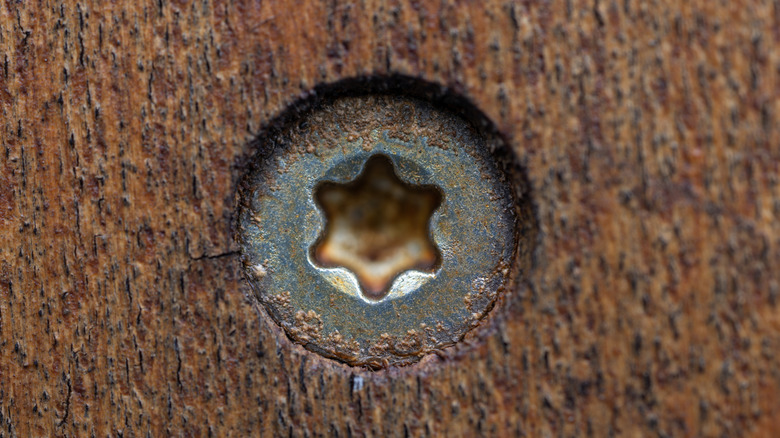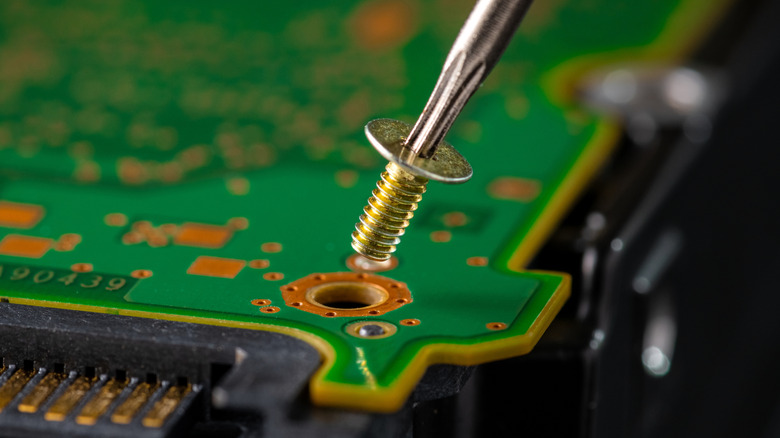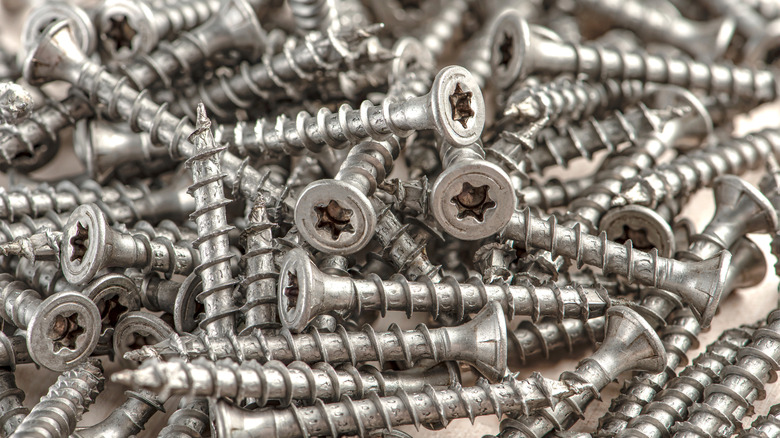Here's The Deal With That Star-Shaped Screw That You're Seeing Everywhere
You're probably pretty sure you know how to use a screwdriver, and you're probably right. But screws evolve, and you know why if you've ever sliced your hand because a slotted screw wouldn't hold your screwdriver in.
That exact problem spawned a number of different types of screws, from Robertson to square-drive to Phillips head screws. Phillips-drive screws won the popularity battle, clearly, but they will ultimately lose the war. That's because of one thing: cam-out, the tendency of some drive designs — particularly Phillips head bits — to slip out of the screw head's drive recess and turn freely. Cam-out has probably happened to you when you've put insufficient force behind a screw that was tough to drive. And here's the thing (fair warning: what you're about to read is tantamount to learning that your father was secretly a super-villain) — for at least some applications, cam-out happened by design, as a way of limiting the torque applied to the screw or the driver. Once torque-limiting technologies improved, more rational options began to emerge that eschewed cam-out in favor of, you know, working properly. Which is great, because intentional cam-out is like reducing the number of calories in a cake by making it taste so bad that it's inedible.
Enter the star-shaped screw in the picture above, which you're starting to see a lot more often. It's not a new design, though. In 1967, Camcar Textron inventor Bernard Reiland dreamed up a better drive recess, and the company received a (now expired) patent for it in 1971. This was the Torx, or star-drive, screw, which is now on its way to taking over the entire screwniverse.
Specs and advantages of the Torx star-shaped screw
Once essentially a security screw, Torx drive fasteners became the standard for certain automotive applications and for the assembly of firearms, where cam-out can be positively disastrous. Today, Torx screws are commonly used in vehicles (including motorcycles and bicycles), computer systems (including hard disk drives), and consumer electronics.
Torx screws, with their six-lobed, star-shaped recesses and fairly tight tolerances for driver bit sizes, are now extremely common fasteners in big-box hardware stores. To hedge against any issues with unfamiliarity or tool compatibility, many boxed screws like Hillman's Deck-Plus wood screws come with a Torx bit that matches the screws, usually a T25. To explain that last point, sizes are designated by a T followed by number indicating the size, most commonly T25 for wood screws. Available Torx sizes range from T1 to T100. You'll occasionally see someone online celebrating the fact that Torx drivers don't come in SAE and metric sizes... but then, neither do Phillips head drivers.
Dramatically less cam-out is the big advantage of Torx. Torx recesses have straight sidewalls that allow drivers to get closer to optimal torque transmission. This reduces damage to fasteners (who doesn't hate a stripped screw?) and can lead to longer tool life (though you'll notice that the aforementioned freebie Torx bits aren't especially long-lived). Finally, while this isn't a technical measurement, Torx drive just feels good. You can tell instantly whether you have a strong, positive contact with your fastener.
Not everything is perfect in Torx City (but it's close)
Torx comes in a number of formats. Each evolved for a specific purpose, and they're not generally compatible with each other. Standard Torx drive (designated by a T or TX in the size nomenclature) will do you no good if you're confronted by an external Torx fastener (designated by an E), which has a male star shape on its head. Torx TR, commonly known as Tamper-Resistant Torx or Security Torx, has a pin in the center of the head so that it can't be driven with Torx or other screwdrivers. And none of the Torx designs with a recess are ideal in uses where the head recess can fill with grime or gunk, like many outdoor scenarios.
Torx, name aside, is also surprisingly limited in terms of how torque it can handle, so the design has already been superseded by something called Torx Plus. Torx Plus is a similar concept that adds more contact area between the driver and screw, resulting in a higher torque capacity. It narrows the tolerance between driver and screw and eliminates the 15-degree drive angle that contributes to bit wear.
If it all seems complicated, it is. The benefits are clear, of course, but complexity has its costs. You'll never be able to use a rotary tool to cut a Torx recess into a one-way screw so you can remove it from window guards, for example, but it's easy to cut a recess for a slotted driver. On the other hand, you're going to need stitches once you get the newly slotted screw out — something which won't happen with a Torx screw. So overall, while Torx isn't perfect, it's the clear champion of the Screw Wars.


